External pumps for wells - features of choice
In systems of autonomous water supply, surface or external pumps have found wide application. They are used to lift water from shallow depths - no more than eight meters, as a rule, and this is enough for water supply of cottages and irrigation of plantations from shallow wells. Next, we look at what these devices represent and how to choose the pump correctly.
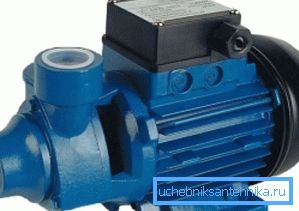
The main difference between surface pumps and submersible (deep) pumps is that the unit itself is located on the surface. It can be in any suitable place, while the suction pipe or hose is lowered to the water source. Such pumps are especially convenient for summer cottages, as they are small and, if necessary, they are easy to connect and disconnect from the water supply.
Next, we consider the existing types, features and device of external pumps, which will make the right choice when buying a device.
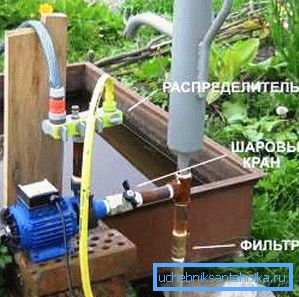
Types of surface pumps
External pumps are of two types:
- Centrifugal;
- Whirling.
Each type of device has its own characteristics, which we consider below.
Whirling
Vortex pumps differ, first of all, compactness. They take up very little free space. In addition, they Bole low price than other types of devices.
The principle of their work is extremely simple - the electric motor rotates the wheel with blades, as a result, the rotational energy is transferred to the liquid, which flows through the inlet nozzle. Due to the compression of water inside the device, there is an increase in its pressure at the outlet.
At the pump inlet, a filter is installed that delays small motes and sand.
Vortex pumps have the following advantages:
- As mentioned above, the devices are small in size, so that they can be installed in a confined space.
- Can raise pressure more significantly than centrifugal pumps of the same capacity.
- They are self-priming, so there is no need to draw water into the nozzle before starting work.
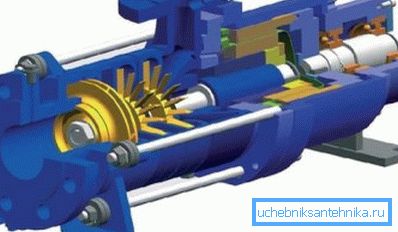
Along with the advantages, these products have some disadvantages:
- Low efficiency, which is not more than 0.45%.
- Impossibility to pump over liquid in which a large number of inclusions. In this case, the blades and the wheel quickly fail. Therefore, vortex pumps can not be used to extract water from wells and wells with sandy bottoms.
Centrifugal
Devices of this type can be used to deliver water from a depth of up to 9 meters. In their device, they largely resemble the pumps described above. The only difference is that the liquid is set in motion due to centrifugal forces, and not by raising it with blades.
To increase the suction depth, the devices have ejectors that are designed to pump air from the system during operation and before it is turned on. External ejectors are more efficiently built, they are installed near the water source after the bottom valve.
Note! When buying a pump, you need to pay attention to the quality of its check valve. Even the highest quality pump can not start after valve depressurization.

The advantages of centrifugal pumps include their low weight and small size. In addition, they can work even with air in the system.
Due to this feature, they are used to draw water from shallow wells and boreholes. At the same time, the cost of such pumps is higher than those considered above.
Tip! When choosing an outdoor pump for a well, it is necessary to pay attention to that it is protected from overheating by a thermal switch.
Application and features of use
Surface pumps are widely used in water supply systems for private homes. However, they cannot be used for pumping other liquids and especially aggressive media. The suction hose must have a strainer.
As for the installation location of the device, it should be selected based on the working conditions. It should be borne in mind that the greater the length of the supply nozzle, the lower the efficiency of the device. In addition, the device is not protected from moisture, for this reason, it is trying to install it in the caisson, directly near the well.
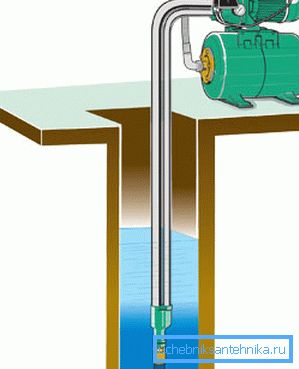
Note! Caisson should be used if the aquifer system will be used in winter. At the same time, it must be installed at a depth of at least 1.5 m.
When operating the equipment, it is necessary to ensure that the engine is always under load. If the pump is empty, water should be added manually.
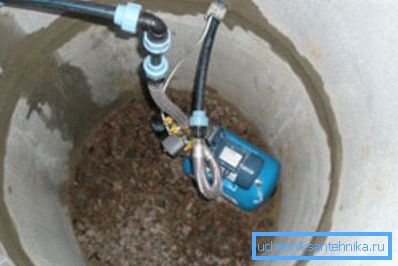
Criteria when choosing a pump
So, the pump is the heart of the system. From the correct choice depends on the uninterrupted water supply of your home.
There are several criteria for selecting a device:
- The main criterion is the depth of the well and the water level in it.. These characteristics are key. Included with the device is an instruction that indicates the optimum depth for which it is designed.
To find out the depth of a well or a well, a rope with a sinker should be placed at the bottom of the water source. You can determine the distance to the water from the dry part of the rope, and the height of the water column from the wet.
- Water demand. Without determining the need for water, it is impossible to choose the right pump. Depending on the model and type of pump, it can vary from 20 to 200 liters per minute.
It is not difficult to calculate the approximate demand - about 200 liters of water are consumed per person per day, respectively, a family of 4 people will need about 50 liters per minute. If the water will also be used for irrigation, it will take about 2000 liters of water per day.
- Head pressure - This is another value that must be considered when choosing a product. To calculate it, the number 30 is added to the well depth and the resulting value is increased by 10 percent. Based on this result, the device is selected.
For example, if the estimated depth was 75m, then increasing it by 10 percent would result in 83m. As a result, the optimal choice will be a model with 90m.
- Finally, determine the allowable cost of the device.. When calculating the cost, it should be borne in mind that you still have to spend money on pipes and other elements. However, you should not strive for cheap. As practice shows, expensive pumps are more durable.
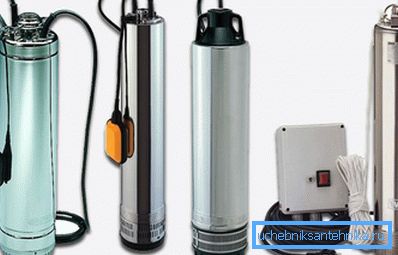
Alternative to external pumps
It is not always possible to use external pumps. They are not able to deliver water from deeper sandy wells, not to mention artesian aquifers located at great depths.
Therefore, in such cases, use of submersible pumps. They are very powerful with compact dimensions. Due to this they can be installed in narrow wells. However, to achieve high technical characteristics, manufacturers have to apply complex technologies, which leads to a significant increase in the cost of devices.
Externally, deep-well pumps have a cylindrical elongated shape, with a length of 0.5 to 2.5 meters. To install such a device with your own hands will not work, because for this you need to have certain skills and equipment.

Note! Submersible pumps cannot be turned on in the air, even for a short time. Expensive models have protection, with the result that the device simply does not turn on, and cheap models can fail.
Conclusion
Summarizing all the above, it should be noted that for the correct selection of the pump, it is necessary to determine the requirements that it must meet. In accordance with them and the characteristics of the well, a certain type and model of the device is selected. Only this way it is possible to provide the estate with uninterrupted water supply.
Additional information on this topic can be obtained from the video in this article.